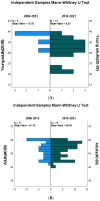Shifting Epidemiology Trends in Tongue Cancer: A Retrospective Cohort Study
- PMID: 38067383
- PMCID: PMC10705286
- DOI: 10.3390/cancers15235680
Shifting Epidemiology Trends in Tongue Cancer: A Retrospective Cohort Study
Abstract
The tongue is the most common site for oral cavity carcinoma. It typically has male predominance. However, several studies have documented an increasing number of incidences among the younger population, with female predominance, which is unusual. In this study, we aimed to determine current trends in tongue cancer regarding age and gender. Data from 197 tongue cancer patients were extracted from The Oncology Center, Mansoura University (OCMU) database from 2006 to 2021. The patients were divided into two time periods: (2006-2013) and (2014-2021). We computed counts and proportions of tongue cancer for demographic and tumor characteristics. The data were analyzed using SPSS. Gender showed no statistically significant difference in both groups, while the percentages of diagnosed females were 52.7% and 52%, respectively. The percentages of males were 47.3% and 48%, p-value = 0.927. There was a statistically significant difference in the number of patients aged 20 to 39 years old and ≥60 years old in both periods. The p-values were 0.039 and 0.011, respectively. Although tongue cancer is typically more common in males, our results showed no significant difference in the gender of diagnosed patients. In addition, our results showed that the number of younger patients significantly increased in the period from 2014 to 2021. However, we encourage further investigations involving larger populations.
Keywords: epidemiology; gender; tongue cancer; young.
Conflict of interest statement
The authors declare no conflict of interest.
Figures





Similar articles
-
Changing trends in oral squamous cell carcinoma with particular reference to young patients: 1971-2006. The Emory University experience.Head Neck Pathol. 2008 Jun;2(2):60-6. doi: 10.1007/s12105-008-0054-5. Epub 2008 May 1. Head Neck Pathol. 2008. PMID: 20614324 Free PMC article.
-
Tongue and tonsil carcinoma: increasing trends in the U.S. population ages 20-44 years.Cancer. 2005 May 1;103(9):1843-9. doi: 10.1002/cncr.20998. Cancer. 2005. PMID: 15772957
-
Epidemiological analysis of tongue cancer in South Australia for the 24-year period, 1977-2001.Aust Dent J. 2006 Mar;51(1):16-22. doi: 10.1111/j.1834-7819.2006.tb00395.x. Aust Dent J. 2006. PMID: 16669472
-
[SENTIERI - Epidemiological Study of Residents in National Priority Contaminated Sites. Sixth Report].Epidemiol Prev. 2023 Jan-Apr;47(1-2 Suppl 1):1-286. doi: 10.19191/EP23.1-2-S1.003. Epidemiol Prev. 2023. PMID: 36825373 Italian.
-
Plasma Cell Myeloma - 20-Year Comparative Survival and Mortality of Three Plasma Cell Myeloma ICD-O-3 Oncologic Phenotypes by Age, Sex, Race, Stage, Cohort Entry Time-Period and Disease Duration: A Systematic Review of 111,041 Cases for Diagnosis Years 1973-2014: (SEER*Stat 8.3.4).J Insur Med. 2018;47(4):203-211. doi: 10.17849/insm-47-04-1-9.1. Epub 2019 Jan 22. J Insur Med. 2018. PMID: 30668210
Cited by
-
Characterization of Salivary Microbiota in Japanese Patients with Oral Cancer.Int J Mol Sci. 2025 Mar 6;26(5):2339. doi: 10.3390/ijms26052339. Int J Mol Sci. 2025. PMID: 40076957 Free PMC article.
-
Oral cancer in Hungary: An epidemiological profile (2015-2019).PLoS One. 2025 Jul 3;20(7):e0327566. doi: 10.1371/journal.pone.0327566. eCollection 2025. PLoS One. 2025. PMID: 40608739 Free PMC article.
References
LinkOut - more resources
Full Text Sources

